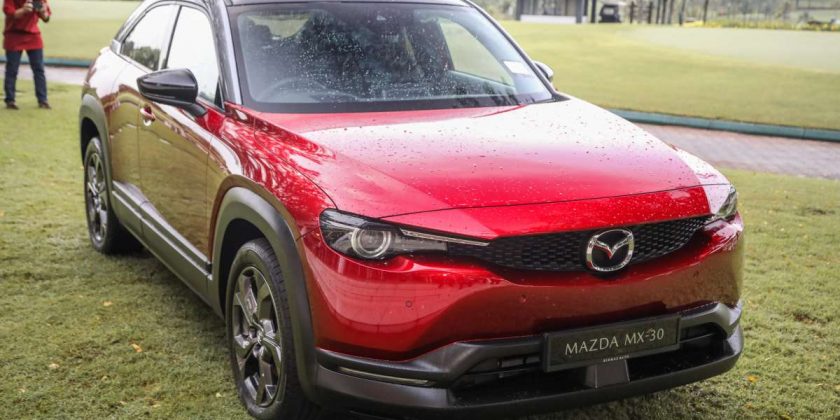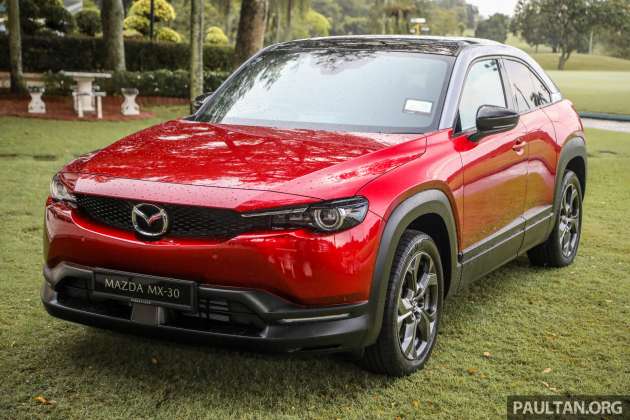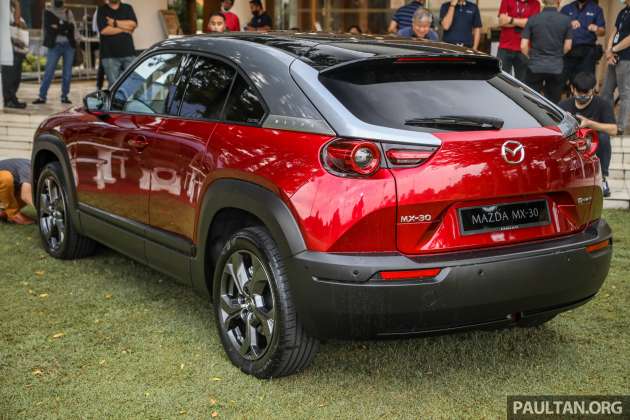The Mazda MX-30 was previewed in Malaysia just a few days ago ahead of a launch set to take place in the fourth quarter of this year. We don’t have official pricing just yet, but Bermaz Auto executive chairman Datuk Seri Ben Yeoh has revealed that the company is working on bringing the price under RM200,000 after factoring in the current incentives the government is providing to electric vehicles.
In terms of specifications, the MX-30 boasts a front-mounted electric motor that provides 145 PS (143 hp or 107 kW) and 271 Nm of torque, which allows for a top speed of 140 km/h and a 0-100 km/h time of 9.7 seconds.
The electric motor draws power from an underfloor-mounted lithium-ion battery with an energy capacity of 35.5 kWh. The battery can be charged via an AC input (Type 2 port) of up to 6.6 kW, and with a wallbox delivering the maximum rate, a full charge takes five hours. There’s also DC fast charging (CCS2 port), with a 0-80% state of charge taking 36 minutes with an input of 40 kW.
A fully charged battery is claimed to deliver 199 km of range, which can be a little troubling for would-be EV buyers with range anxiety. As we mentioned in our original post, buyers with a maximum budget of RM200,000 for a new EV will have several options besides the MX-30. For instance, the Hyundai Kona Electric is offered in three variants with prices ranging from RM149,888 to RM199,888.
There’s also the MINI Cooper SE 3 Door (RM178,240.73), Nissan Leaf (RM168,000) as well as the base variant (Lite) of the Hyundai Ioniq 5 (RM199,888) beneath said price point. These non-Mazda alternatives are all capable of delivering over 199 km of range, as we list out below:
- Hyundai Kona Electric – 39.2 kWh, 305 km; 64 kWh, 484 km (WLTP)
- MINI Cooper SE 3 Door – 28.9 kWh, 232 km (WLTP)
- Nissan Leaf – 40 kWh, 311 km (NEDC)
- Hyundai Ioniq 5 Lite – 58 kWh, 384 km (WLTP)
This begs the question: why does the MX-30 come with a smaller battery and less range than most of the competition under RM200,000? On a related note, what is the MX-30’s target market given its specifications?
This question was posed to Yeoh during a Q&A session following the unveiling of the MX-30 recently. According to Yeoh, the MX-30 is more of a “utility vehicle” aimed at a different segment of customers that only require a city runabout where daily drives won’t exceed 100 km. It’s likely such customers aren’t too demanding when it comes performance either.
Mazda’s decisions for the MX-30 were deliberate to minimise the vehicle’s environmental impact, which includes the entire manufacturing process. As explained in an Automotive News Canada report, the MX-30’s battery was sized according to the emissions generated from producing the car’s electrical components and factoring in a battery swap at 160,000 km to “maintain battery performance.”
The carmaker notes that EVs with larger batteries are more polluting over their life cycles, and there’s few instances where customers will require a copious amount of range on their routine commutes.
Additionally, a smaller battery also makes an EV lighter and allows the MX-30 to stay true to Mazda’s reputation of providing vehicles that are fun to drive. A lower weight also contributes to making the vehicle more efficient, while also reducing wear and tear on things like tyres and brakes.
With these considerations, Yeoh said the MX-30 is a well-balanced vehicle for its use case and that it is the job of the company manage the expectations of customers. What are your thoughts on Mazda’s reasoning? If you had to put down money, how much are you willing to pay for the MX-30?
Source: Read Full Article



